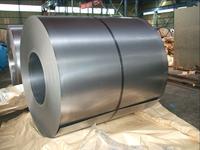Cold rolling发表评论(0)编辑词条
Cold rolling
Cold rolling is a metalworking process in which metal is deformed by passing it through rollers at a temperature below its recrystallization temperature. Cold rolling increases the yield strength and hardness of a metal by introducing defects into the metal's crystal structure. These defects prevent further slip and can reduce the grain size of the metal, resulting in Hall-Petch hardening.
Cold rolling is most often used to decrease the thickness of plate and sheet metal.
Physical metallurgy of cold rolling
Cold rolling is a method of cold working a metal. When a metal is cold worked, microscopic defects are nucleated throughout the deformed area. These defects can be either point defects (a vacancy on the crystal lattice) or a line defect (an extra half plane of atoms jammed in a crystal). As defects accumulate through deformation, it becomes increasingly more difficult for slip, or the movement of defects, to occur. This results in a hardening of the metal.
If enough grains split apart, a grain may split into two or more grains in order to minimize the strain energy of the system. When large grains split into smaller grains, the alloy hardens as a result of the Hall-Petch relationship. If cold work is continued, the hardened metal may fracture.
During cold rolling, metal absorbs a great deal of energy. Some of this energy is used to nucleate and move defects (and subsequently deform the metal). The remainder of the energy is released as heat.
While cold rolling increases the hardness and strength of a metal, it also results in a large decrease in ductility. Thus metals strengthened by cold rolling are more sensitive to the presence of cracks and are prone to brittle fracture.
A metal that has been hardened by cold rolling can be softened by annealing. Annealing will relieve stresses, allow grain growth, and restore the original properties of the alloy. Ductility is also restored by annealing. Thus, after annealing, the metal may be further cold rolled without fracturing.
Degree of cold work
Cold rolled metal is given a rating based on the degree it was cold worked. "Skin-rolled" metal undergoes the least rolling, being compressed only 0.5-1% to harden the surface of the metal and make it more easily workable for later processes. Higher ratings are "quarter hard," "half hard" and "full hard"; in the last of these, the thickness of the metal is reduced by 50%.
Cold rolling as a manufacturing process
Cold rolling is a common manufacturing process. It is often used to form sheet metal. Beverage cans are closed by rolling, and steel food cans are strengthened by rolling ribs into their sides. Rolling mills are commonly used to precisely reduce the thickness of strip and sheet metals.
Foil rolling
Foil rolling is a continuous deformation process compressing metal between a pair of rollers called work rolls.[1]
Foil is produced for several applications:
Thermal insulation for the construction industry
Fin stock for air conditioners
Electrical coils for transformers
Capacitors for radios and televisions
Insulation for storage tanks
Decorative products
Containers and packaging
Foil stock is reduced in thickness by a rolling mill, where the material is passed several times through metal work rolls. As the sheets of metal pass through the rolls, they are squeezed thinner and extruded through the gap between the rolls. The work rolls are paired with heavier rolls called backup rolls, which apply pressure to help maintain the stability of the work rolls. The work and backup rolls rotate in opposite directions. As the foil sheets come through the rollers, they are trimmed and slitted with circular or razor-like knives installed on the rolling mill. Trimming refers to the edges of the foil, while slitting involves cutting it into several sheets.[2]
Aluminium alloys are most commonly produced in the foil rolling process because the raw materials necessary for its manufacture are abundant. Aluminium foil is inexpensive, durable, non-toxic, and greaseproof. Iron, silicon, and manganese are all major alloying elements. Sheet metals with a thickness below 200 micrometers are considered foils (Some foils may be as thin as 6.3 micrometers).[3]
Foil rolling is a commonly used method of metal compression. Ingots cast from molten metal begin the thinning process as they are set between a series of rollers with one set rolling across the top and one set rolling across the bottom. These ingots are handled by forklifts due to their extreme weight. Small work rolls are supported by larger rolls that apply pressure, helping to maintain the work rolls. Each set of rollers rotates in opposite directions. The intensity is carefully monitored by technicians who adjust the pressure as necessary. The ingots pass through the rollers back and forth several times, becoming slimmer with each ru
n. [4]
In many cases the rollers are heated to assist in the workability of the metal. The temperature of the rollers usually sits around 455 to 540 degrees Celsius. To keep the ingots from sticking to the rollers everything is flushed often with a cooling fluid composed of 95% water, 5% oil. [5] According to final product specifications the metal deformation can be adjusted by changing the rpm of the rolls, the roller resistance and the temperature of the rollers. [6] Certain personal hazards should be identified such as moving work pieces, scorching rollers and metal, sharp razors and heavy materials.
Foil rolling is used in the manufacturing of many different products including but not limited to:
- aluminum foil
- candy wrappers
- art and decoration
- insulation
- packaging materials[7]
Once the sheets of metal have been pressed thinly enough they are trimmed and cut to appropriate size.
冷轧
冷轧钢冷轧:在再结晶温度以下进行的轧制叫做冷轧,一般用热轧钢卷为原料,经酸洗去除氧化皮后进行冷连轧,其成品为轧硬卷,由于连续冷变形引起的冷作硬化使轧硬卷的强度、硬度上升、韧塑指标下降,因此冲压性能将恶化,只能用于简单变形的零件。轧硬卷可作为热镀锌厂的原料,因为热镀锌机组均设置有退 火线。轧硬卷重一般在20-40吨,钢卷在常温下,对热轧酸洗卷进行连续轧制。内径为610mm。
产品特点:因为没有经过退火处理,其硬度很高(HRB大于90),机械加工性能极差,只能进行简单的有方向性的小于90度的折弯加工(垂直于卷取方向)。
简单点儿来说,冷轧,是在热轧板卷的基础上加工轧制出来的,一般来讲是热轧---酸洗--磷化--皂化--冷轧这样的加工过程。
冷轧是在常温状态下由热轧板加工而成,虽然在加工过程因为轧制也会使钢板升温,尽管如此还是叫冷轧。由于热轧经过连续冷变型而成的冷轧,在机械性能比较差,硬度太高。必须经过退火才能恢复其机械性能,没有退火的叫轧硬卷。轧硬卷一般是用来做无需折弯,拉伸的产品,1.0以下厚度轧硬的运气好的两边或者四边折弯。
补充修正:冷轧一般都会经过退火处理。
在冷轧过程中必须使用冷轧油,使用冷轧油的好处是:1、有效降低磨擦系数,提供相应的轧制力,轧制能耗低,获得满意的轧制参数;2、使表面光亮度高、轧延厚度均匀;3、冷却效果好,能迅速带走轧制热,保护轧辊及轧件。 退火性能良好,不会产生油烧现象;4、有短期的防锈性能,可提供轧件临时防锈保护;
与“cold rolling,冷轧,轧钢工艺”相关的词条
→如果您认为本词条还有待完善,请 编辑词条
词条内容仅供参考,如果您需要解决具体问题
(尤其在法律、医学等领域),建议您咨询相关领域专业人士。
0
标签: cold rolling 冷轧 轧钢工艺

同义词: 暂无同义词
关于本词条的评论 (共0条)发表评论>>








